🎤 Interview with Alexander Taylor
2024年 5月 30日
We talked with seasoned developer Alexander Taylor about Japanese life and indie roguelikes, as well as his work on the forthcoming deck-building puzzle game, Witching Stone!
English
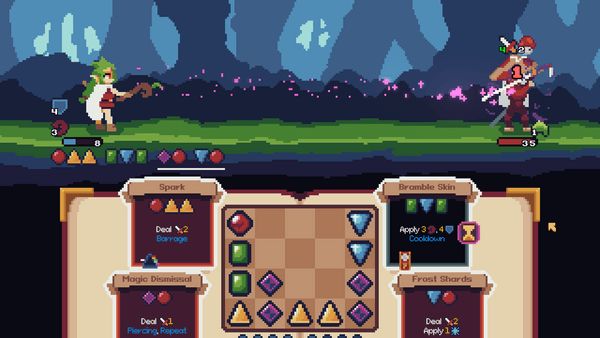
(in development) Witching Stone
# Please tell us a little bit about yourself and your life in Japan.
Hello, I am Alex Taylor. I am originally from a small village in the middle of England. I’ve bounced around a few games companies around the UK but I am now I’m full time indie. So far I’ve released two games and I’m working on a third.
I am living in Japan! I met my wife in London, who makes data analysis software for glycobiology researchers trying to make medicine. Which I think, in terms of human value, is about equivalent to me deciding that rockets shouldn’t trigger headshot damage because they are a splash weapon.
Her work is dependent on grants and she had an offer that involved her moving back to Japan. As I was just doing solo indie stuff at this point we decided why not? The only major downside is I did not manage to sneak in 10 years of studying Japanese so it is a bit of a struggle sometimes.
I really like Japan. I have come before as a tourist but living is completely different. I’m not eating out everyday, visiting shrines, or popping out to Akihabara to buy pop culture figurines and have a maid ketchup my name onto an omelette. I’m working, grocery shopping, and trying to work the photocopier in Family Mart. But compared to London the quality of life is much better and about a quarter of the price.
# How did you get started making games?
When I was a teenager I spent a lot of time in mapping communities for Half-Life and Warcraft 3. And I did occasionally make levels when I wasn’t being an edgy loser.
I didn’t have particularly good grades at school and I was working a data entry job at an accountants office for a lighting company, and kind of assumed I’d be doing that forever. But one of my internet friends gave me a push to apply to Creative Assembly and managed to get a level scripting position with my little portfolio.
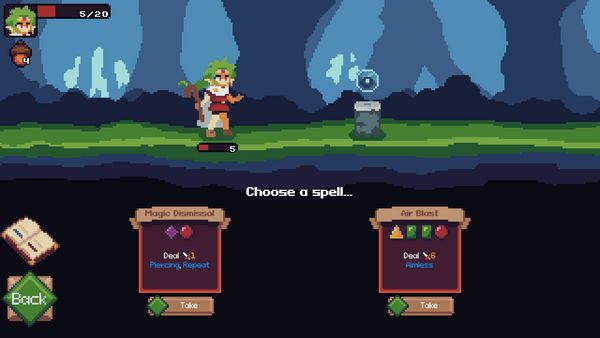
# Please tell us about Witching Stone!
Witching Stone is a combination of tile-matching puzzle and roguelike.
In combat you have a grid of coloured stones, similar to something you might see in Bejeweled or Puzzle & Dragons, but rather than trying to match them together you draw a path through them. You also have some spells, the default maximum is 4, and each spell has a stone sequence. Match the sequence along your path and it goes off!
Each run gives you a different dungeon with different loot and enemies. And you spend most of your time out of combat curating your spellbook, deciding which spells and upgrades to take.
There is a surprising amount of strategy. Combat itself has the usual quirks of enemies who attack, defend, buff, debuff, summon, etc., but you also have to manage your board, stone status effects, spell status effects, etc. There’s also macro strategy around making sure your spells are not only complementary in function but cast sequence.
The game has a demo playable right now on itch.io and Steam.
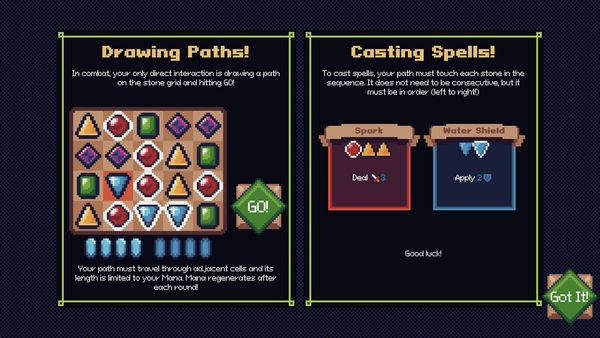
# Can you tell us about the process of making Witching Stone? Was it different from the way you approached making your other games?
I was originally making a different game with the temporary name “Roguelink”. This was my take on Grindstone, but it turns out I had basically recreated another game called Alchemy Stars.
While the core gameplay was fun, I structured it like a roguelike and this was a mistake. The upgrades rarely actually affected the main interaction of running down a path hitting enemies.
I parked the project and did a series of prototypes to try and fix this. Eventually I had a 1v1 wizard fight, where you both took turns to draw on a match board. But optimal play involved working out where the gems would land to deny your opponent, which added a layer of skill that was incredibly boring and annoying. So I ended up having enemies work in the standard card battler way.
I still have a lot of affection for the first Roguelink game and I might return to it later. It just needs a more fitting structure. Also, it was very naive to think making it a roguelike would save any time. You need to make so much content!
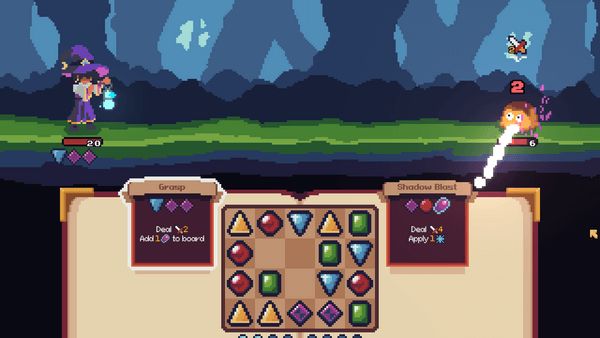
# I know that you mentioned really getting into pixel art for this game. Can you tell us what you learned? Are there any sprites or animations in particular that you are proud of?
I was kind of reluctant to try making my own art. But it’s a big part of a game and I didn’t really have a plan otherwise. I don’t think I’ve “found my voice” but I do think it’s serviceable and I can communicate the gameplay. I’m proud of the shopkeeper transformation and people always give it a “cuuute!” which makes me smile.
There are some very obvious inspirations like rdein’s Momodora and Melfand Stories. I hope in future projects I am a bit less derivative. I should also say I have used asset packs! At the time of writing these can be credited to uta_vit999, Ansimuz and Pimen. And the pixel fonts are by castpixel and GGBot.
# What was your greatest influence when making Witching Stone?
I’ve seen a lot of people describe it using Slay the Spire and that makes sense. But I would say Grindstone, Wildfrost, Dicey Dungeons and Slice & Dice are probably bigger gameplay influences.
Some elements, including the titular witching stone, come from Welsh folklore but it’s not “inspired” or grounded in it. One of the first bosses has a samurai sword! But it’s just a common well I revisit.
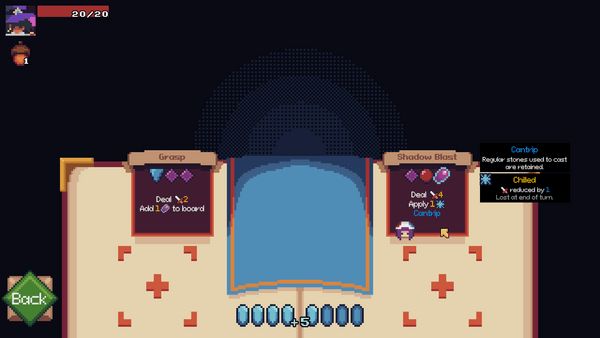
# What was the most challenging part of making Witching Stone?
To be honest, balancing the game is an ongoing nightmare that only gets worse as the dungeon gets deeper! I decided every act should have its own loot because I want the player to keep managing their spellbook all run, but that means a lot of content along a power curve.
I mostly fill these out based on a weird budget sheet and vibes. I have a spell that deals damage based on how many Chilled stacks are on enemies. Is it good? Well it depends how many Chilled sources you have, how much enemies care about that status, and what badges (spell upgrades) you have!
One of the biggest problems was going round in circles on what “balanced” looks like, as this could mean a bunch of things to different people. So I’ve instead defined my own balance design goal. And my goal isn’t that every option has an equal win rate and pick rate. I actually think high power variance is fun! But the player should never get so unlucky they never had a chance.
A lot of big roguelikes have analytics that let them pull up the win rate and pick rate for every option and item the player gets. It is tempting to put in a system like that, and it would be interesting to see reports like win rate by run count per player, etc. But it’s not cheap to plug in one of these services and get a Tableau licence, and I’m not sure how I would actually use the data in practice.
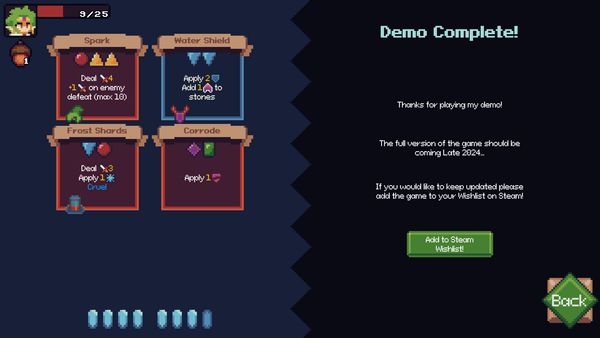
# I know that you’ve brought Witching Stone to a few events already, and have made the demo public. Can you tell us what the hands-on reaction has been like?
I wish we had indie shows like Tokyo Game Dungeon in the UK. There’s no jury or expensive fees or priority list, and everyone gets the same floor space. It’s much more welcoming to experimental games and hobbyist developers.
Reaction at these events has been positive! A few people played it and clearly weren’t having a nice time, perhaps got jumpscared by all the roguelike elements, but everyone is very polite.
A few money people popped by and gave me business cards, but I don’t think I need a publisher for this project… Nice to be wanted, though!
# Is there anything in Witching Stone to which you want to draw the player’s attention?
Yeah! A lot of people like the cool anime illustrations and awesome music. These are by Sam Miller and Noelle Amelie Aman.
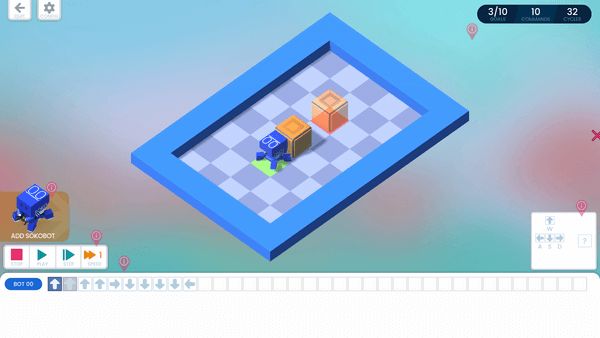
(2022) SOKOBOT
# Can you tell us about other games you worked on in the past?
As an indie developer I’ve released two games, SOKOBOT and Touhou Library Survivors. These are a programming game and my take on a Vampire Survivors clone. I tend not to stick around in a single genre, but the connective tissue is they use a cute exterior to hide they are nerd games for nerds.
My history before that is that I worked at various studios in the UK. The only title I worked on that’s actually reviewed well was Alien: Isolation, but it would be cheeky to suggest I played a significant part as I left a couple of years in. And certainly the credits agree!
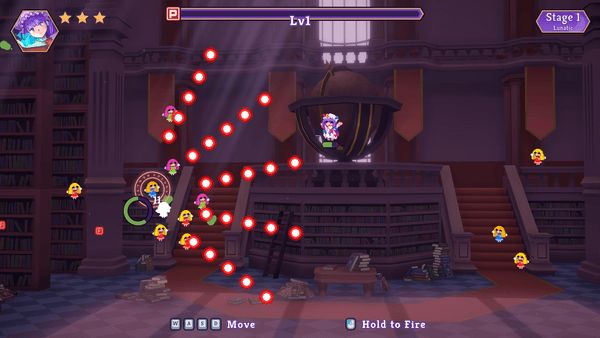
(2022) Touhou Library Survivors
# Can you tell us about anything you are currently working on?
Right now I’m only focused on Witching Stone!
# Thank you for sharing your thoughts with us!
日本語訳
日本語訳:ダイコン

(開発中) Witching Stone
# 自己紹介と日本での生活について教えてください。
こんにちは、アレックス・テイラーです。私はイングランド中部の小さな村の出身です。英国中のいくつかのゲーム会社を渡り歩いてきましたが、今はフルタイムのインディー開発者です。これまでに2つのゲームをリリースし、現在3つ目のゲームを開発中です。
私は日本に住んでいます!ロンドンで妻に会いました。彼女は薬品のための糖鎖生物学の研究者向けデータ分析ソフトを作成しています。これは、人類の価値という点において、ロケット弾は飛沫兵器であるためヘッドショットによるダメージを引き起こすべきではないと判断するのとほぼ同じだと思います。
彼女の仕事は助成金に依存しており、日本への帰国を伴うオファーを受けていました。この時点で私はちょうどソロでインディー活動をしており、そのオファーを受けてみようということになりました。唯一の問題は、10年間日本語を勉強してきたわけではないので、時々少し苦労することです。
私は日本が大好きです。以前に観光客として来たことがありますが、生活はまったく異なります。毎日外食したり、神社に行ったり、秋葉原に行ってポップカルチャーのフィギュアを買ったり、メイドさんにオムレツに私の名前をケチャップかけてもらったりしているわけではありません。私は仕事をし、食料品の買い物をし、ファミリーマートでコピー機を動かそうとしています。しかし、ロンドンに比べて生活の質ははるかに良く、物価は約4分の1です。
# ゲームを作り始めたきっかけについて教えてください。
私は10代の頃、「Half-Life」や「Warcraft 3」のマッピングのコミュニティに多くの時間を費やしました。そして、調子がいいときには時々レベルの作成もしていました。
学校の成績は特に良くなく、照明会社の会計事務所でデータ入力の仕事をしており、この仕事を一生続けるだろうと思っていました。しかし、インターネット上の友人の1人が私にCreative Assemblyへの応募を後押しし、私の小さなポートフォリオでなんとかレベルスクリプティングの職を得ることができました。

# 「Witching Stone」というゲームについて教えてください。
「Witching Stone」は、タイルマッチングパズルとローグライクを組み合わせたゲームです。戦闘では、「Bejeweled」や「パズル&ドラゴンズ」のような石のグリッドがあり、それらを合わせるのではなく、それらを通り道を描きます。
いくつかの呪文があり、デフォルトの最大値は4で、各呪文は石の順番の指定があります。通り道に沿ってその順番を一致させれば、呪文が起動します。実行するたびに、異なる報酬と敵がいる異なるダンジョンが表示されます。そして、戦闘以外の時間のほとんどは、呪文の本を整理し、呪文の選択とどの呪文のアップグレードを採用するかを決定します。
戦略が驚くほどたくさんあります。戦闘自体には、攻撃、防御、バフ、デバフ、召喚などの敵の行動がありますが、ボードや石のステータス効果、呪文のステータス効果なども管理する必要があります。呪文を確実に使用するためのマクロ戦略もあります。機能だけでなくキャストシーケンスも相補的です。
このゲームは、itch.ioとSteamで今すぐプレイできるデモがあります。

# 「Witching Stone」をどのように制作なさったかを教えてください。ほかのゲームを作るときのアプローチとは違いますか。
元々は「Roguelink」という仮名で別のゲームを作っていました。「Grindstone」に対する私の見解として作成していましたが、基本的には「Alchemy Stars」という別のゲームを再作成したことが判明しました。
核となるゲームプレイは楽しかったのですが、ローグライクのような構造にしたのですが、これは間違いでした。道を走って敵を攻撃するという主なやり取りで得られるアップグレードに良い効果はほとんどありませんでした。
私はプロジェクトを一旦保留し、修正のためのプロトタイプを作成しました。 最終的には1対1の魔法使いの戦いになり、二人が交代で対戦ボードに絵を描くことになりました。しかし、最適なプレイには、相手を攻撃するために宝石がどこに着地するかを計算する必要があり、退屈で迷惑なスキルの層が追加されました。そこで、最終的には標準的なカードバトラーの方法で敵キャラを動かすことになりました。
私はローグリンクの最初のゲームに今でも大きな愛情を持っているので、後で戻ってくるかもしれません。より適切な構造が必要です。また、ローグライクにすれば時間を節約できると考えるのは非常に甘かったです。たくさんのコンテンツを作成する必要があります。

# このゲームではドット絵に本格的に取り組んでいると伺いました。どのようなことを学んだのか教えていただけますか? 特に誇りに思っているスプライトやアニメーションはありますか。
私は自分の絵を作ることに少し抵抗がありました。しかし、それはゲームの重要な部分であり、それ以外の計画は特にありませんでした。「自分の声を見つけた」とは思っていませんが、役に立つものであり、ゲームプレイにつながっています。私はショップ店長の変身シーンを誇りに思っており、人々はいつも「かわいい!」と言ってくれ、とてもうれしいです。
rdeinさんの「Momodora」や「メルファンドストーリーズ」のような、非常に明白なインスピレーションがいくつかあります。今後のプロジェクトでは、派生的要素が少し減ることを願っています。私もアセットパックを使用したことがあります。この記事の執筆時点では、これらはuta_vit999、Ansimuz、Pimenの功績であると考えられます。そしてピクセルフォントはcastpixelとGGBotによるものです。
# 「Witching Stone」を制作する際に最も大きな影響を受けたものは何ですか。
多くの人がこのゲームを「Slay the Spire」を使って説明しているのを見てきており、それは理にかなっています。しかし、「Grindstone」、「ワイルドフロスト」、「Dicey Dungeons」、「Slice & Dice」がおそらくゲームプレイに大きな影響を与えていると思います。
タイトルの「Witching Stone」を含むいくつかの要素はウェールズの民間伝承に由来していますが、それに「インスピレーションを得た」ものでも、それに基づいたものでもありません。最初のボスの1人はサムライソードを持っています。ただ、よくあるテーマとして描いています。

# 「Witching Stone」の作成に当たり最も挑戦したことは何ですか。
正直に言うと、ゲームのバランス調整は悪夢のようなもので、深みにはまるほど悪夢はさらに悪化します。プレイヤーがスペルブックをすべて実行し続けられるようにするため、すべてのアクトに独自の報酬があるべきだと判断しましたが、それは難易度の曲線に沿って多くのコンテンツが必要になります。
私は多くの場合、不思議な計画表と雰囲気に基づいてこれらを記入していきます。敵にあるスローダウンの効果を積み重ねた数にしたがってダメージを与える呪文があります。それは、スローダウンのソースがいくつあるか、敵がそのステータスをどれだけ気にするか、バッジ(呪文のアップグレード)を持っているかによって決まります!
最も大きな問題のひとつは、「バランスが取れている 」とはどういうことなのかについて堂々巡りになることでした。これは、さまざまな人にとってさまざまな意味を持つ可能性があるためです。そこで私は代わりに、独自のバランス設計目標を定義しました。 そして、私の目標は、すべてのオプションの勝率と選択率が同じになることではありません。実際、パワーのばらつきがあること自体は楽しいと思います!しかし、プレイヤーは絶対的にチャンスがないような不運に見舞われるべきではないでしょう。
大規模なローグライクゲームの多くには、プレーヤーが取得するすべてのオプションとアイテムの勝率とピック率を引き上げる分析機能が備わっています。 このようなシステムを導入したくなるのは魅力的ですし、プレーヤーごとのラン数ごとの勝率などのレポートを見るのは興味深いでしょう。しかし、これらのサービスの1つを接続してTableauライセンスを取得するのは安くはありません。 実際にデータをどのように使用するかわかりません。

# 「Witching Stone」はいくつかのイベントでも公開されていますが、プレイヤーの方々の反応はどうですか。
東京ゲームダンジョンのようなインディーチャンネルがイギリスにもあればいいのにと思います。
審査や高額な手数料、優先順位リストはなく、全員が同じフロアスペースを利用できます。実験的なゲームや趣味の開発者にとっては、はるかに歓迎されています。これらのイベントでの反応は好評です。
何名かのプレイヤーは明らかに楽しい時間を過ごしていませんでした。おそらくすべてのローグライクの要素が好ましくなかったようですが、皆さんはとても礼儀正しいです。 お金を持っている人たちが何人か立ち寄って、私に名刺をくれましたが、このプロジェクトにパブリッシャーは必要ないと思います…でも、求められるのは嬉しいことです!
# 「Witching Stone」でプレイヤーに注目してもらいたい点があったら教えてください。
クールなアニメイラストと素晴らしい音楽が好きな人はたくさんいました。これらはサム・ミラーさんとノエル・アメリ・アマンさんによるものです。

(2022) SOKOBOT
# 過去に取り組んだほかのゲームについて教えてください。
インディー開発者として、私は「SOKOBOT」と「東方文殿生存 ~Library Survivors~」という2つのゲームをリリースしました。これらはプログラミングゲームと、「ヴァンパイア・サバイバーズ」のクローンを私なりに作ったものです。私はひとつのジャンルにこだわらない傾向があるのですが、オタクのためのオタクゲームであることを隠すために、かわいらしい外見を使っているのがつなぎ目になっています。
それ以前の経歴は、イギリスのいろいろなスタジオで働いていました。私が手掛けたタイトルで実際にレビューが良かったのは「エイリアン アイソレーション」だけですが、数年で辞めたので、私が重要な役割を果たしたと言うのは生意気でしょう。確かにクレジットもそうだ!

(2022) 東方文殿生存 ~Library Survivors~
# 現在取り組んでいるプロジェクトはありますか。
今は、「Witching Stone」に集中しています!
# この度はインタビューにご協力いただき誠にありがとうございます。

